Apple TV Review: Easy Interface, Limited Content
This set-top box may be the best choice for heavy iTunes and Apple product users, but it has less content than competitors and a dated design.
Why you can trust Tom's Guide

Apple TV has the backing of legions of fans, because the $99 set-top box connects to iTunes, allowing them to watch or listen to all their purchased media files on the big screen. The Apple TV is also AirPlay ready, which means iPhone, iPad and Mac owners can beam content from their devices directly to their home theaters. On the downside, Apple limits the offerings on its set-top box, providing access to fewer content services than competitors such as Roku.
Editors’ Note: Apple has announced a new version of the Apple TV featuring an new operating system based on iOS, a remote with built-in touch and voice controls and a redesigned interface with app support. It’s scheduled for release in October and starts at $149.
MORE: Roku vs. Apple TV vs. Chromecast: Which Device Wins?
Design

Although categorized as set-top boxes, little gadgets such as Apple TV are more the size of a hamburger bun or hockey puck. Apple TV can be hidden under or beside a TV without being conspicuous (as long as its IR receiver on the front is still visible). The Apple TV is a little bigger (3.9 x 3.9 x 0.9 inches, 9.6 ounces) than the $100 Roku 3 (3.5 x 3.5 x 1 inches, 5 ounces), but the size differences are inconsequential. If you really want something small and unobtrusive, you can go with the $50 Roku Streaming Stick (see review) and Google's $35 Chromecast, which are about 3 inches long and plug directly into an HDMI port on the back of a TV.
Setup

Connecting the Apple TV to a Wi-Fi network is relatively painless and comparable to the process on its competitors. A setup guide takes you to a screen to enter your Wi-Fi username and password by pecking out letters and numbers using an onscreen keyboard and the remote. (You can also connect it using an Ethernet cable.) However, the initial setup of the Home Sharing feature is obtuse. It fails to mention, for example, that the computer you're linking to must be authorized for iTunes content before you will even see the option in the iTunes menu. But once you've struggled through the setup, things work smoothly. Most of the services on Apple TV require a monthly subscription or on-demand fees, so as a final step, you will sign into the apps for the services you already have, such as Hulu Plus or Netflix, using the onscreen keyboard again.
A dedicated remote control is included, but an HDMI cable is not. You can pick one up for about $10 from online retailers.
Interface
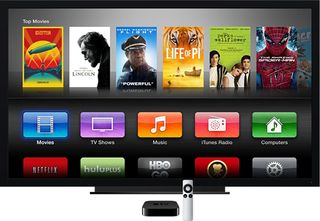
Apple hews closely to the interface used on its iPad and iPhone — which works well enough on those smaller screens but looks dated and mundane on a large HDTV. The listings appear as plain, rectangular icons of identical size that you click onto using the four-way directional pad on the remote, then tap the select button in the center. However, the blue border highlight meant to indicate which app icon you are on is difficult to see.
Within each channel, Apple has a very consistent (some might say rigid) interface that imposes its design on every app. So Netflix looks different here than it does on a PS3, Roku or smart TV, for example. It's not as spiffy, and a bit confusing with a rotating left-hand gallery of movie or TV stills and a vertical menu on the right. The design matches that of other Apple TV apps — YouTube looks identical — but it will seem alien to anyone who's used Netflix on another device.
Remote Control
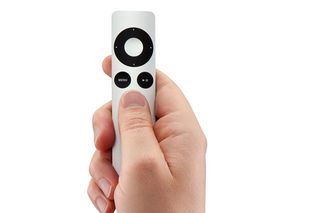
Apple TV's tiny, aluminum remote is minimalist and easy to use. A black ring at the top of the remote acts as a four-way directional pad when you're navigating in apps, and handles fast forward (by clicking the right side) and rewind (by clicking the left) when you are playing videos or music. Pressing a metal button in the center of the ring allows you to select an item. Below the ring are just two buttons: Menu, which acts as a back button, and a Play/Pause button.
This is an IR remote, meaning you have to place the Apple TV so that the IR receiver is visible from your couch and aim the remote when you want to make a selection. Newer competitors such as the Roku 3 and Streaming Stick and Amazon Fire TV use RF remotes that don’t depend on line of sight. (You can, however, use the Apple Remote app from a smartphone, which works over your Wi-Fi network.)
While Apple also has a remote control app for smartphones, you're better off using the physical remote. Apple has struggled with the remote-control app for the iPad, for example. Its combination of touch, swipe and button taps is awkward, confusing and frustrating. It's not obvious how to invoke menus or move between choices, and it does not follow the same swipe and tap conventions as, say, the iPad itself.
MORE: Your Guide to Cable TV Cord-Cutting
Search
The one area where the app bests the remote control is in searching for titles. Rather than clicking through the alphabet on screen, one can more quickly tap out words on an iPad or iPhone screen. If you want to see which online services, such as Netflix or Hulu Plus, have a show you are looking for, and also see what iTunes charges to purchase it, you'll have to search each app individually. Roku, by comparison, allows you to search across many content providers at once.
Amazon is also starting to expand its voice-enabled universal search coverage on the new Fire TV (see review). Voice-controlled searches via Siri are not enabled on Apple TV; so Amazon's Fire TV is the natural winner here.
Performance
All the major streaming players — Amazon Fire TV, Apple TV, Google Chromecast, and most Rokus — deliver 1080p HD video. The image quality generally depends on the strength of your Internet connection more than on the device, however.
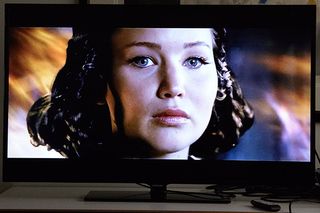
In terms of responsiveness, the Apple TV interface is agile, so you never feel like you're waiting for that interminable download symbol to extinguish. YouTube is quick off the mark here, as are most of the other services.
But all is not perfection. We managed to confuse the Apple TV by switching between services. We experimented with playing our iTunes radio stations, for example, and then attempted to launch a program on the Korean programming station, KORTV. The music continued to play, but the video never appeared. Rebooting the box cleared up the problem.
Content
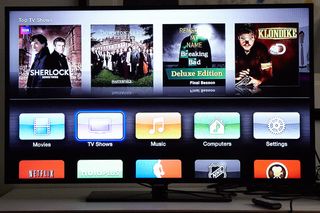
First and foremost, Apple TV is designed to deliver movies and music from iTunes. Therefore, it has a limited number of choices, unless you want to purchase everything from iTunes and forgo a lot of the apps and services the other devices offer. Yes, Apple TV has YouTube, Netflix, MLB.com, HBO Go and Hulu, but not Pandora or Spotify. Instead you get iTunes Radio, which is unfortunate, given its poor streaming audio quality.
On Apple TV, you can purchase or rent titles from iTunes, whereas Roku supports Amazon Instant Video and several other services such as Blockbuster, Vudu and Redbox.
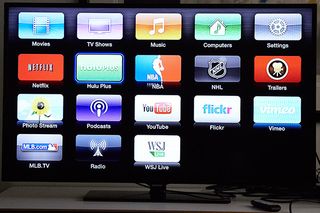
Nevertheless, Apple TV is not without free entertainment options, such as YouTube, PBS, Vimeo and ad-supported movie distributer (and now original show provider) Crackle.
MORE: Top 10 Online Streaming Video Services
Apple TV completely lacks social media integration, with no support for Facebook or other major social-networking apps. Apple also hasn't made games available on Apple TV, the way that Roku and Amazon have on their boxes.
You can get other entertainment options on Apple TV if you are a Mac or iOS device owner. Apple TV's AirPlay feature allows you to beam video or music content to the device over your Wi-Fi connection — from online sources or files on your device. The quality is sketchy, however. Video sometimes freezes or stutters, so it's not a perfect solution for the lack of native content apps on Apple TV. (Third-party apps such as AirParrot and AllCast promise AirPlay compatibility for PCs and Android devices, respectively.)
Verdict

For Apple-centric households, Apple TV is a handy accessory that gives users access to the iTunes library and content from Apple devices on their home theaters. However, those intent on becoming cord-cutters (people who have chosen to get rid of their cable-TV service) will have a difficult time living on Apple TV alone. They would do better with the far-wider content selection, and powerful search tool, on Roku devices such as the Roku 3 and Roku Streaming Stick.
There have been rumors for two years that a new Apple TV box is imminent, and there is much speculation that this June the company may introduce a new, more powerful, and flexible model to match competitors such as Roku and newcomers like Amazon Fire TV and its gaming features. As yet, none has appeared, stymied by the lack of content deals to deliver network TV channels over the box. But Apple needs a refresh, and this may be the year. If you are a heavy Apple product user but not in a rush to get a set-top box, it may be worth waiting a few more months to see what surfaces.
Sign up to get the BEST of Tom’s Guide direct to your inbox.
Upgrade your life with a daily dose of the biggest tech news, lifestyle hacks and our curated analysis. Be the first to know about cutting-edge gadgets and the hottest deals.
John R. Quain has been reviewing and testing video and audio equipment for more than 20 years. For Tom's Guide, he has reviewed televisions, HDTV antennas, electric bikes, electric cars, as well as other outdoor equipment. He is currently a contributor to The New York Times and the CBS News television program.

